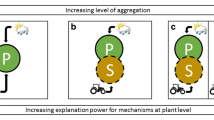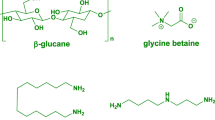Abstract
Rapid changes in the Earth’s atmosphere and climate associated with human activity can have significant impacts on agriculture including livestock production. CO2 concentration has risen from the industrial revolution to the current time, and is expected to continue to rise. Climatic changes alter physiological processes, growth, and development in numerous plant species, potentially changing concentrations of plant secondary compounds. These physiological changes may influence plant population density, growth, fitness, and toxin concentrations and thus influence the risk of toxic plants to grazing livestock. Locoweeds, swainsonine-containing Astragalus species, are one group of plants that may be influenced by climate change. We evaluated how two different swainsonine-containing Astragalus species responded to elevated CO2 concentrations. Measurements of biomass, crude protein, water soluble carbohydrates and swainsonine concentrations were measured in two chemotypes (positive and negative for swainsonine) of each species after growth at CO2 levels near present day and at projected future concentrations. Biomass and water soluble carbohydrate concentrations responded positively while crude protein concentrations responded negatively to elevated CO2 in the two species. Swainsonine concentrations were not strongly affected by elevated CO2 in the two species. In the different chemotypes, biomass responded negatively and crude protein concentrations responded positively in the swainsonine-positive plants compared to the swainsonine-negative plants. Ultimately, changes in CO2 and endophyte status will likely alter multiple physiological responses in toxic plants such as locoweed, but it is difficult to predict how these changes will impact plant herbivore interactions.





Similar content being viewed by others
References
Ainsworth EA, Long SP (2005) What have we learned from 15 years of free-air CO2 enrichment (FACE)? A meta-analytic review of the responses of photosynthesis, canopy. New Phytol 165:351–371. doi:10.1111/j.1469-8137.2004.01224.x
AOAC (2012) Official methods of analysis, 19th edn. Assoc Off Anal Chem, Arlington
Bach Knudsen KE (1997) Carbohydrate and lignin contents of plant materials used in animal feeding. Anim. Feed Sci Technol 67:319–338. doi:10.1016/S0377-8401(97)00009-6
Barillas JRV, Paschke MW, Ralphs MH, Child RD (2007) White locoweed toxicity is facilitated by a fungal endophyte and nitrogen-fixing bacteria. Ecology 88:1850–1856. doi:10.1890/06-0728.1
Baucom D, Romero M, Belfon R, Creamer R (2012) Two new species of Undifilum, the swainsonine producing fungal endophyte, from Astragalus species of locoweed in the United States. Botany 90:866–875. doi:10.1139/b2012-056
Bazzaz FA (1990) The response of natural ecosystems to the rising global CO2 levels. Annu Rev Ecol Syst 21:167–196
Braun K, Romero J, Liddell C, Creamer R (2003) Production of swainsonine by fungal endophytes of locoweed. Mycol Res 107:980–988. doi:10.1017/S095375620300813X
Brosi GB, McCulley RL, Bush LP, Nelson JA, Classen AT, Norby RJ (2011) Effects of multiple climate change factors on the tall fescue–fungal endophyte symbiosis: infection frequency and tissue chemistry. New Phytol 189:797–805. doi:10.1111/j.1469-8137.2010.03532.x
Cheplick GP, Clay K, Marks S (1989) Interactions between infection by endophytic fungi and nutrient limitation in the grasses Lolium perenne and Festuca arundinacea. New Phytol 111:89–97. doi:10.1111/j.1469-8137.1989.tb04222
Clay K (1990) Comparative demography of three graminoids infected by systemic, clavicipitaceous fungi. Ecology 71:558–570. doi:10.2307/1940309
Colegate SM, Dorling PR, Huxtable CR (1979) A spectroscopic investigation of swainsonine: an alpha-mannosidase inhibitor isolated from Swainsona canescens. Aust J Chem 32:2257–2264. doi:10.1071/CH9792257
Coley PD, Bryant JP, Chapin FS (1985) Resource availability and plant antiherbivore defense. Science 230:895–899. doi:10.1126/science.230.4728.895
Cook D, Ralphs MH, Welch KD, Stegelmeier BL (2009a) Locoweed poisoning in livestock. Rangelands 31:16–21. doi:10.2111/1551-501X-31.1.16
Cook D, Gardner DR, Ralphs MH, Pfister JA, Welch KD, Green BT (2009b) Swainsonine concentrations and endophyte amounts of Undifilum oxytropis in different plant parts of Oxytropis sericea. J Chem Ecol 35:1272–1278. doi:10.1007/s10886-009-9710-9
Cook D, Gardner DR, Grum D, Pfister JA, Ralphs MH, Welch KD, Green BT (2011) Swainsonine and endophyte relationships in Astragalus mollissimus and Astragalus lentiginosus. J Agric Food Chem 59:1281–1287. doi:10.1021/jf103551t
Cook D, Beaulieu WT, Mott IW, Riet-Correa F, Gardner DR, Grum D, Pfister JA, Clay K, Marcolongo-Pereira C (2013a) Production of the alkaloid swainsonine by a fungal endosymbiont of the ascomycete order Chaetothyriales in the host Ipomoea carnea. J Agric Food Chem 61:3797–3803. doi:10.1021/jf4008423
Cook D, Grum DS, Gardner DR, Welch KD, Pfister JA (2013b) Influence of endophyte genotype on swainsonine concentrations in Oxytropis sericea. Toxicon 61:105–111. doi:10.1016/j.toxicon.2012.10.018
Cook D, Gardner DR, Pfister JA (2014) Swainsonine-containing plants and their relationship to endophytic fungi. J Agric Food Chem 62:7326–7334. doi:10.1021/jf501674r
Coviella CE, Stipanovic RD, Trumble JT (2002) Plant allocation to defensive compounds: interactions between elevated CO2 and nitrogen in transgenic cotton plants. J Exp Bot 53:323–331. doi:10.1093/jexbot/53.367.323
Cruz JL, Alves AA, Lecain DR, Ellis DD, Morgan JA (2014) Effect of elevated CO2 concentration and nitrate: ammonium ratios on gas exchange and growth of cassava (Manihot esculenta Crantz). Plant Soil 374:33–43. doi:10.1007/s11104-013-1869-8
Delaney KJ, Klypnia N, Maruthvanan J, Lange C, Sterling TM (2011) Locoweed dose response to nitrogen: positive for biomass and primary physiology, but inconsistent for an alkaloid. Am J Bot 98:1956–1965. doi:10.3732/ajb.1100133
Dorling PR, Huxtable CR, Colegate SM (1980) Inhibition of lysosomal α-mannosidase by swainsonine, an indolizidine alkaloid isolated from Swainsona canescens. Biochem J 191:649–651. doi:10.1042/bj1910649
Eberson HW, West CP (1996) Growth and water relations of field-grown tall fescue as influenced by drought and endophyte. Grass Forage Sci 51:333–342. doi:10.1111/j.1365-2494.1996.tb02068.x
Gao X, Cook D, Ralphs MH, Yan L, Gardner DR, Lee ST, Panter KE, Han B, Zhao ML (2012) Detection of swainsonine and isolation of the endophyte Undifilum from the major locoweeds in Inner Mongolia. Biochem Syst Ecol 45:79–85. doi:10.1016/j.bse.2012.07.012
Gardner DR, Cook D (2011) A comparison of alternative sample preparation procedures for the analysis of swainsonine using LC-MS/MS. Phytochem Anal 22:124–127. doi:10.1002/pca.1257
Gardner DR, Molyneux RJ, Ralphs MH (2001) Analysis of swainsonine: extraction methods, detection, and measurement in populations of locoweeds (Oxytropis spp.) J Agric Food Chem 49:4573–4580. doi:10.1021/jf010596p
Grum DS, Cook D, Baucom D, Mott IW, Gardner DR, Creamer R, Allen JG (2013). Production of the alkaloid swainsonine by a fungal endophyte in the host. J Nat Prod 76(10):1984–1988
Heyworth CJ, Iason GR, Temperton V, Jarvis PG, Duncan AJ (1998) The effect of elevated CO2 concentration and nutrient supply on carbon-based plant secondary metabolites in Pinus sylvestris L. Oecologia 115:344–350. doi:10.1007/s004420050526
Hoagland DR, Arnon DI (1950) The water-culture medium for growing plants without soil. Calif Agric Exp Stn 347:4–32
Hunt MG, Rasmussen S, Newton PC, Parsons AJ, Newman JA (2005) Near-term impacts of elevated CO2, nitrogen and fungal endophyte-infection on Lolium perenne L. growth, chemical composition and alkaloid production. Plant Cell Environ 28:1345–1354. doi:10.1111/j.1365-3040.2005.01367.x
Intergovernmental Panel on Climate Change (IPCC) (2007) The physical science basis. Contribution of working group i to the fourth assessment report of the intergovernmental panel on climate change. Cambridge University Press, Cambridge
Lawrence DP, Rotondo F, Gannibal PB (2016) Biodiversity and taxonomy of the pleomorphic genus Alternaria. Mycol Prog 15:1–22. doi:10.1007/s11557-015-1144-x
Lerdau M, Coley PD (2002) Benefits of the carbon-nutrient balance hypothesis. Oikos 98:534–536. doi:10.1034/j.1600-0706.2002.980318.x
Marks S, Clay K (1990) Effects of CO2 enrichment, nutrient addition, and fungal endophyte-infection on the growth of two grasses. Oecologia 84:207–214. doi:10.1007/BF00318273
Mattson WJ (1980) Herbivory in relation to plant nitrogen content. Annu Rev Ecol Syst 11:119–161
Newman JA, Abner ML, Dado RG, Gibson DJ, Brookings A, Parsons AJ (2003) Effects of elevated CO2, nitrogen and fungal endophyte-infection on tall fescue: growth, photosynthesis, chemical composition and digestibility. Glob Chang Biol 9:425–437. doi:10.1046/j.1365-2486.2003.00601.x
Oldrup E, McLain-Romero J, Padilla A, Moya A, Gardner DR, Creamer R (2010) Localization of endophytic Undifilum fungi in locoweed seed and influence of environmental parameters on a locoweed in vitro culture system. Botany 88:512–521. doi:10.1139/B10-026
Panter KE, James LF, Stegelmeier BL, Ralphs MH, Pfister JA (1999) Locoweeds: effects on reproduction in livestock. J Nat Toxins 8:53–62 PMID:10091128
Prentice IC, Farquhar GD, Fasham MJR, Goulden ML, Heimann M, Jaramillo VJ, Kheshgi HS, Le Quere C, Scholes RJ, Wallace DWR (2001) The carbon cycle and atmospheric carbon dioxide. In: Houghton JT, Ding Y, Griggs DJ, Noguer M, van der Linden PJ, Dai X, Maskell K, Johnson CA (eds) Climate Change 2001: The Scientific Basis. Cambridge University Press, Cambridge, pp 183–237
Pryor BM, Creamer R, Shoemaker RA, McClain-Romero J, Hambleton S (2009) Undifilum, a new genus for endophytic Embellisia oxytropis and parasitic Helminthosporium bornmuelleri on legumes. Botany 87:178–194. doi:10.1139/B08-130
Ralphs MH, Creamer R, Baucom D, Gardner DR, Welch SL, Graham JD, Hart C, Cook D, Stegelmeier BL (2008) Relationship between the endophyte Embellisia spp. and the toxic alkaloid swainsonine in major locoweed species (Astragalus and Oxytropis). J Chem Ecol 34:32–38. doi:10.1007/s10886-007-9399-6
Ralphs MH, Cook D, Gardner DR, Grum DS (2011) Transmission of the locoweed endophyte to the next generation of plants. Fungal Ecol 4:251–255. doi:10.1016/j.funeco.2011.03.001
Ren AZ, Gao YB, Wang W, Wang JL, Zhao NX (2009) Influence of nitrogen fertilizer and endophyte infection on ecophysiological parameters and mineral element content of perennial ryegrass. J Integr Plant Biol 51:75–83. doi:10.1111/j.1744-7909.2008.00721.x
Ryan GD, Rasmussen S, Xue H, Parsons AJ, Newman JA (2014) Metabolite analysis of the effects of elevated CO2 and nitrogen fertilization on the association between tall fescue (Schedonorus arundinaceus) and its fungal symbiont Neotyphodium coenophialum. Plant Cell Environ 37:204–212. doi:10.1111/pce.12146
Sun J, Yang L, Wang Y, Ort DR (2009) FACE-ing global change: opportunities for improvement in photosynthetic radiation use efficiency and crop yield. Plant Sci 177:511–522. doi:10.1016/j.plantsci.2009.08.003
Taub DR, Miller B, Allen H (2008) Effects of elevated CO2 on the protein concentration of food crops: a meta-analysis. Glob Chang Biol 14:565–575. doi:10.1111/j.1365-2486.2007.01511.x
Tulsiani DR, Broquist HP, James LF, Touster O (1988) Production of hybrid glycoproteins and accumulation of oligosaccharides in the brain of sheep and pigs administered swainsonine or locoweed. Arch Biochem Biophys 264:607–617. doi:10.1016/0003-9861(88)90327-X
Wang Q, Nagao H, Li Y, Wang H, Kakishima M (2006) Embellisia oxytropis, a new species isolated from Oxytropis kansuensis in China. Mycotaxon 95:255–260. doi:10.3114/sim0015
Wiles PG, Gray IK, Kissling RC (1998) Routine analysis of proteins by Kjeldahl and dumas methods: review and interlaboratory study using dairy products. J Assoc Off Anal Chem 81:620–632 PMID:9606925
Woudenberg JHC, Gronewald JZ, Binder M, Crous PW (2013) Alternaria redefined. Stud Mycol 75:171–212. doi:10.3114/sim0015
Yu Y, Zhao Q, Wang J, Wang J, Wang Y, Song Y, Geng G, Li Q (2010) Swainsonine-producing fungal endophyte from major locoweed species in China. Toxicon 56:330–338. doi:10.1016/j.toxicon.2010.03.020
Ziska LH, Emche SD, Johnson EL, George K, Reed DR, Sicher RC (2005) Alterations in the production and concentration of selected alkaloids as a function of rising atmospheric carbon dioxide and air temperature: implications for ethno-pharmacology. Glob Chang Biol 11:1798–1807. doi:10.1111/j.1365-2486.2005.001029.x
Zobayed SSPK, Saxena PK (2004) Production of St. John’s wort plants under controlled environment for maximizing biomass and secondary metabolites. In Vitro Cell Dev Biol Plant 40:108–114. doi:10.1079/IVP2003498
Acknowledgements
The authors would like to thank Dan LeCain and Jessie Roper for their technical assistance.
Author information
Authors and Affiliations
Corresponding author
Rights and permissions
About this article
Cite this article
Cook, D., Gardner, D.R., Pfister, J.A. et al. Effects of Elevated CO2 on the Swainsonine Chemotypes of Astragalus lentiginosus and Astragalus mollissimus . J Chem Ecol 43, 307–316 (2017). https://doi.org/10.1007/s10886-017-0820-5
Received:
Revised:
Accepted:
Published:
Issue Date:
DOI: https://doi.org/10.1007/s10886-017-0820-5




